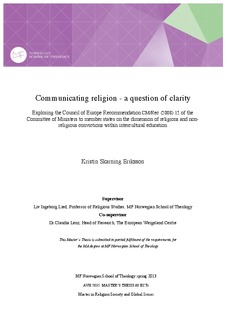Communicating religion - a question of clarity : Exploring the Council of Europe Recommendation CM/Rec (2008) 12 of the Committee of Ministers to member states on the dimension of religions and non-religious convictions within intercultural education
Master thesis
Permanent lenke
http://hdl.handle.net/11250/161239Utgivelsesdato
2013-09-09Metadata
Vis full innførselSamlinger
Sammendrag
The Council of Europe is engaged in promoting education for democratic citizenship through
an intercultural education approach. Within this approach is a religious dimension. A
Recommendation by the Committee of Ministers was issued in 2008: ‘The Recommendation
CM/Rec (2008) 12 of the Committee of Ministers to member states on the dimension of
religions and non-religious convictions within intercultural education’. This is a policy
document on how to introduce the concept in education policies, institutions and the
development of teacher training. The aim of the Recommendation is to ensure the dimension
of religions and non-religious convictions within intercultural education is accepted as a
contribution to strengthen human rights, democratic citizenship and participation, and to the
development of competences for intercultural dialogue.
The study is an exploration of the communication on religion described in the above policy
document. An interpretative approach was used to search for different meanings of ‘religion’
and ‘religious dimension’. A tentative impression was that different actors had employed
diverging meanings of the concepts in the Recommendation, and that this resulted in a textual
tension in the document. A document analysis was performed with tools from domain
analysis and text revision theory with an appreciation of how discourses are established. The
Recommendation was compared with a draft version and supplementary material. The
analysis was interpretative and focused on meaning and intention. A theoretical discussion
followed with the aim of seeing how discourses on religion and society were reflected in the
Recommendation.
The analysis showed that there had been many amendments to the text. These appeared as
adjustments and conceptually new meanings of policy. Traces of different discourses were
found, especially on ‘religion’ and ‘religion as a cultural fact’. Partial, rather than complete
replacements of concepts, resulted in a lack of clarity in the Recommendation and uncertainty
regarding Council of Europe Policy on the role and place of religion. ‘Religion’ was for
instance defined both including and excluding secular worldviews. ‘Religion as a cultural
fact’ and ‘religions and non-religious convictions as cultural facts’, were used intermittently
in an inconsistent manner in the Recommendation and its Explanatory Memorandum. The conclusion was that there is a textual tension in the Recommendation. I suggest that the alterations that were presented in the analysis might be a result of the background of the
various contributors to the writing and editing process. There is also reason to question
whether the intention of the Council of Europe in paying attention to an increasing religious
diversity through building competence for dialogue is maintained. The Council recognised
that the earlier lack of attention to the importance of religion and values for individual and
social identity had to be reversed in order to build a cohesive society. I suggest that the
introduction of ‘non-religious convictions’ is blurring this intention. The communication on
religion does not display the clarity that would seem required in order to promote the project
of learning about religion and values in an intercultural education approach.
